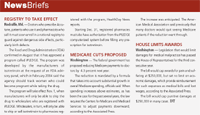- Acne
- Actinic Keratosis
- Aesthetics
- Alopecia
- Atopic Dermatitis
- Buy-and-Bill
- COVID-19
- Case-Based Roundtable
- Chronic Hand Eczema
- Chronic Spontaneous Urticaria
- Drug Watch
- Eczema
- General Dermatology
- Hidradenitis Suppurativa
- Melasma
- NP and PA
- Pediatric Dermatology
- Pigmentary Disorders
- Practice Management
- Precision Medicine and Biologics
- Prurigo Nodularis
- Psoriasis
- Psoriatic Arthritis
- Rare Disease
- Rosacea
- Skin Cancer
- Vitiligo
- Wound Care
Article
Understanding the rising prevalence of treated disease
National report — The driving force behind the growth in private insurance spending between 1987 and 2002 was the rise in treated disease prevalence, rather than the rise in spending per treated case, according to a new study from Emory University in Atlanta.

Researchers reported their results examining the spending on the top 20 medical conditions responsible for the greatest dollar growth in private health insurance spending. Together, these conditions accounted for 67 percent of the growth in private health insurance spending during the 15-year study period.
The category of skin disorders was ranked fifteenth, after heart disease and before bronchitis and endocrine disorders.
The study
Dr. Thorpe and colleagues broke the potential causes for private health insurance spending into two categories: the rise in the number of patients being treated for medical conditions and the cost of treating the patient per year.
"We used a national data set that allowed us to link individuals to spending and then their medical conditions that they reported," Dr. Thorpe tells Dermatology Times. "We looked at the change in spending over a 15-year period ... and picked the 20 medical conditions that accounted for most of the growth in spending. We then looked among those medical conditions to see how much of a growth in spending within each medical condition was due to the fact that we were treating more cases, versus the fact that it was costing more to treat a person with a particular medical condition."
The authors' basic conclusion was that about 62 percent of the growth in spending per person over that 15-year period was linked to the fact that doctors are treating more patients with a whole variety of medical conditions.
Pinpointing causes
Looking for what accounted for this explosion of treated disease, Dr. Thorpe and colleagues found a whole host of population risk factors, led by obesity; then stress health issues.
"We have seen a doubling of obesity during this time period, and with it about a 60 percent increase (or tripling) of diabetes prevalence; a tripling, if not more, in treatments of lipids and a doubling of arthritis," he says. "If you look at the chronic conditions that are associated with obesity, the obesity increases in the population have generated a whole host of new chronic illnesses that are largely responsible for the growth. The growth in obesity, by itself, is accounting for about 30 percent of the total growth in health care spending in the 15 years."
Skin disorders
When they looked specifically at skin disorders, they found that the 58 percent of the growth of spending per person during the 15-year period was linked to the fact that doctors have had an increase in the number of patients being treated for skin disorders.
The researchers used ICD-9 codes to develop four major groupings under the umbrella of skin disorders: skin and subcutaneous tissue infections; other inflammations of the skin; chronic ulcers of the skin; and other skin disorders.
While the researchers have not yet looked individually about those skin disorder categories, Dr. Thorpe says that, for skin disorders, the rise in treated prevalence was about 37 percent, going from 6,695 treated prevalence per 100,000 in 1987 to 9,144 in 2002. The cost per treated case in 1987 was $344 versus $471 in 2002. And skin disorders represented 2.0 percent contribution to total growth in spending from '87 to '02 increase.
Newsletter
Like what you’re reading? Subscribe to Dermatology Times for weekly updates on therapies, innovations, and real-world practice tips.
















